Após anos criando sites WordPress, aprendemos como é importante ter uma configuração local do WordPress em seu computador.
Ter o WordPress em sua máquina pessoal permite que você experimente novos recursos sem arriscar seu site ao vivo, mergulhe fundo no desenvolvimento do WordPress e até mesmo crie sites inteiros antes de eles entrarem no ar. É como ter uma caixa de areia particular para todos os seus projetos do WordPress.
Se você é um usuário do Windows, há várias maneiras de configurar o WordPress localmente. Mas reduzimos a lista para os dois métodos mais fáceis. Neste guia, mostraremos como instalar facilmente o WordPress em um computador com Windows, independentemente da versão que estiver usando.
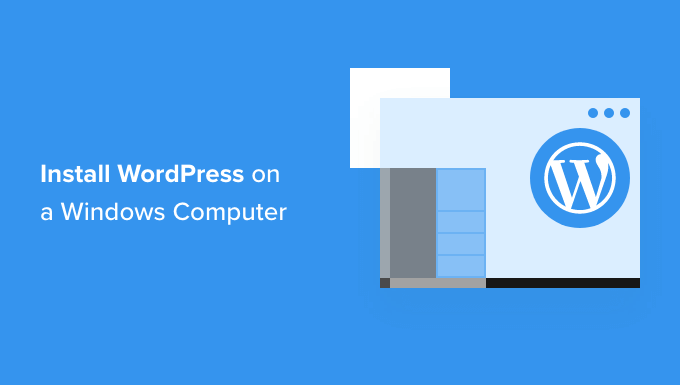
Por que você deve instalar o WordPress no Windows?
Se você for usuário do Windows, a instalação do WordPress localmente no seu computador oferece vários benefícios.
Uma instalação local do WordPress cria um ambiente de teste que não afeta seu site ativo. Essa configuração, geralmente chamada de servidor local ou localhost, é seu playground pessoal para o WordPress.
Os desenvolvedores do WordPress usam regularmente instalações locais para seu trabalho. Por exemplo, eles podem usá-las para experimentar novos plugins ou temas ou testar o site antes de atualizar para o editor de blocos Gutenberg.
Mas isso não é apenas para os profissionais. Se você é novo no WordPress, uma configuração local é perfeita para aprender. Você pode explorar recursos, testar temas e plug-ins e fazer experimentos livremente sem se preocupar em danificar um site ativo.
É importante observar que, quando você instala o WordPress localmente no Windows, somente você pode ver o site. Se quiser criar um site público, você precisará de um nome de domínio e de hospedagem na Web.
Agora, tecnicamente, você pode instalar o WordPress no Windows usando o XAMPP, e já escrevemos um tutorial sobre isso.
Dito isso, descobrimos duas maneiras ainda mais simples do que o XAMPP para configurar um ambiente local do WordPress, o que as torna excelentes para iniciantes ou usuários que precisam criar um site local rapidamente. Você pode clicar no link abaixo para avançar para qualquer método de seu interesse:
Método 1: Instalar o WordPress no Windows usando o Studio (rápido e simples)
Para o primeiro método, usaremos o Studio. É um software WordPress local criado pela Automattic, a empresa que gerencia e administra o WordPress.com, que é um construtor de sites baseado no software WordPress.
Falaremos sobre esse método primeiro porque ele é muito mais rápido e simples de seguir, o que o torna perfeito para iniciantes.
Primeiro, você precisa abrir o site Studio by WordPress.com. Em seguida, clique no botão “Download for Windows”.

Depois de fazer isso, basta abrir o arquivo baixado para iniciar a instalação.
Uma janela pop-up será exibida, mostrando que o aplicativo está sendo instalado.
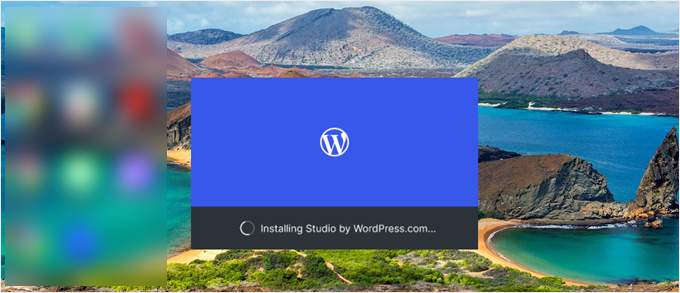
Com isso feito, você pode adicionar seu primeiro site.
Para fazer isso, basta digitar o nome do novo site local do WordPress e clicar em “Adicionar site”. Você pode nomear o site como quiser, desde que isso ajude a identificá-lo facilmente.
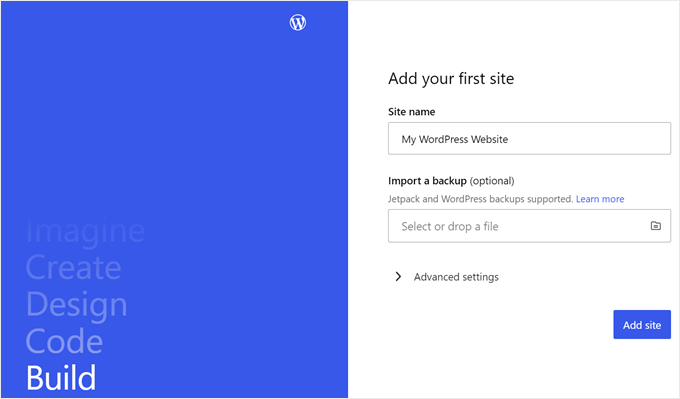
Agora você deve ver o painel do site local do WordPress.
Para acessar o painel do WordPress e editar o site, basta clicar no botão “Iniciar” no canto superior direito. Isso tornará seu site local acessível em seu computador.
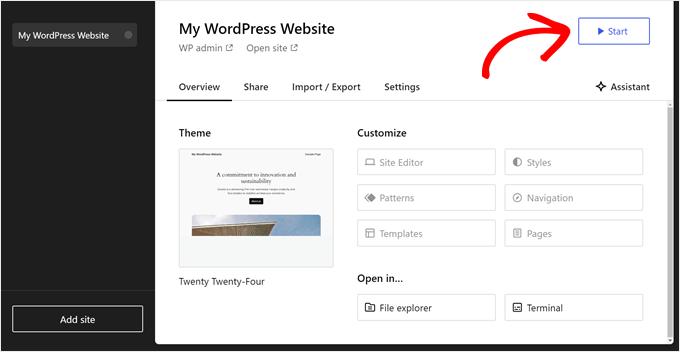
Quando o botão “Start” (Iniciar) mudar para “Running” (Em execução), você poderá clicar no link “WP Admin” (Administração do WP) no canto superior esquerdo da página.
Isso o levará à página de administração local do WordPress.

E isso é praticamente tudo para a configuração. Vamos explorar as outras configurações que podem ser necessárias à medida que você cria seu site local.
Como você pode ver na guia “Overview” (Visão geral), é possível acessar imediatamente o menu do editor de site completo do WordPress diretamente do painel do Studio. Você também pode clicar em “File explorer” (Explorador de arquivos) para abrir as pastas e os arquivos do seu site WordPress e clicar em “Terminal” para gerenciar seu site usando o WP-CLI.
Se você mudar para a guia “Compartilhar”, poderá fazer login na sua conta do WordPress.com, clonar seu site local e carregá-lo nos servidores do WordPress.com. Isso tornará o site clonado temporariamente on-line, o que é útil para compartilhar sites de demonstração com seus clientes ou membros da equipe.
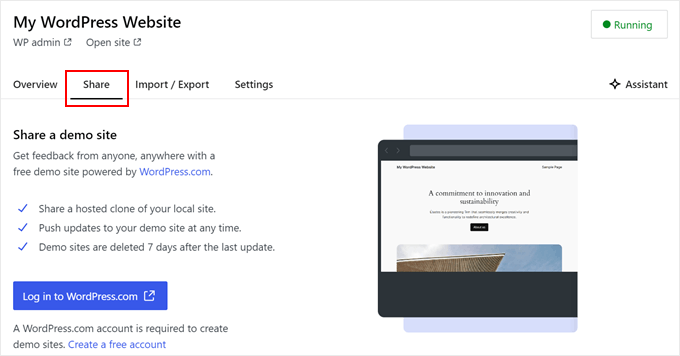
Às vezes, você pode querer fazer login no seu site local diretamente pelo navegador em vez de usar o Studio. Nesse caso, você precisa saber suas credenciais de wp-admin.
Para encontrá-los, vá para a guia “Configurações” e encontre o nome de usuário, a senha e o URL de login do administrador do WordPress.
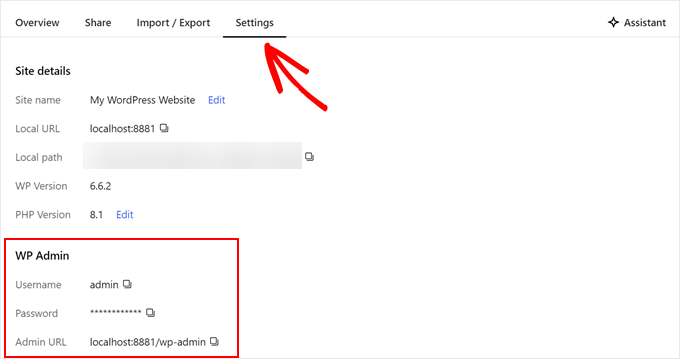
Outro recurso interessante do Studio é o chatbot de IA incorporado, com o qual você pode se comunicar clicando no botão “Assistant”.
Aqui, você pode pedir ajuda ao Studio em tarefas como atualizar todos os seus plug-ins de uma só vez, atualizar a versão principal do WordPress ou criar código para um bloco personalizado.

Quando terminar de trabalhar em seu site local, basta passar o mouse sobre o botão “Running” (Em execução) no canto superior direito até que ele diga “Stop” (Parar).
Em seguida, clique no botão para interromper o site.

Uma desvantagem do Studio é que você não pode configurar o ambiente do WordPress a seu gosto. Isso significa que você precisa usar a versão do PHP, o servidor da Web e o banco de dados que foram pré-selecionados para você.
Isso pode ser uma desvantagem se você precisar testar seu site ou plug-in com configurações de servidor específicas.
Se precisar de mais controle sobre o ambiente local do WordPress ou se precisar combinar sua configuração local com uma configuração específica de servidor ativo, confira o próximo método usando o Local WP.
Método 2: Instalar o WordPress no Windows usando o WP local (mais personalizável)
Primeiro, você precisa fazer o download e instalar o software Local WP em seu computador Windows. Basta acessar o site do Local WP e clicar no botão “Download for Free”.
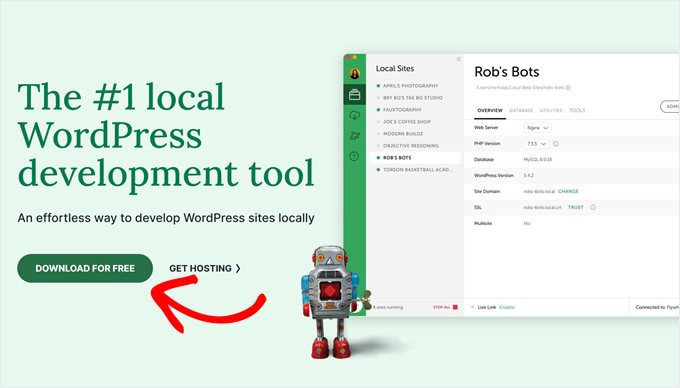
Depois disso, será exibida uma janela pop-up na qual você precisará selecionar a plataforma. Vá em frente e escolha “Windows” no menu suspenso.
Em seguida, insira seus dados, como nome e sobrenome, endereço de e-mail profissional e número de telefone para fazer o download do software.

Depois de inserir os detalhes, basta clicar no botão “Get it Now”.
Depois disso, o software será baixado automaticamente em seu computador. Caso contrário, você pode clicar no link “clique aqui” para iniciar o download.

Depois que o arquivo for baixado, inicie o assistente de configuração.
Agora, você precisará selecionar se deseja instalar o software para todos os usuários ou apenas para você.
Depois de selecionar uma opção, clique no botão “Next” (Avançar).
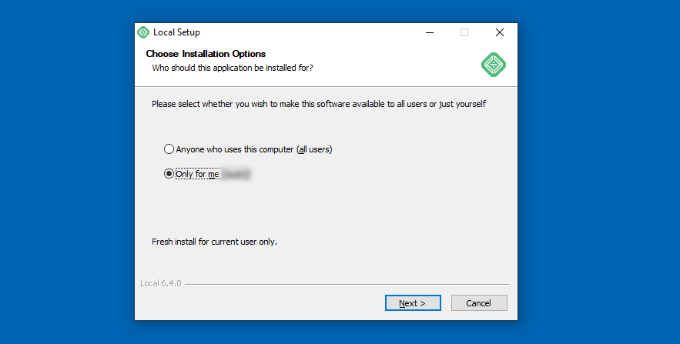
Na próxima etapa, você pode selecionar a “Pasta de destino” onde o software será instalado.
Basta clicar no botão “Procurar” para definir o caminho e, em seguida, clicar no botão “Instalar”.
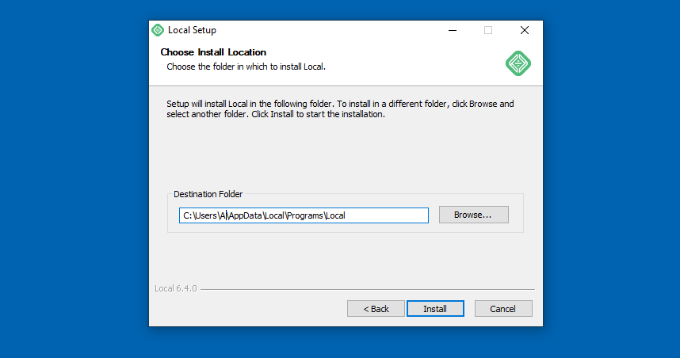
O software Local WP será instalado em seu computador Windows.
Depois de concluído, você pode marcar a caixa de seleção “Run Local” (Executar local) e clicar no botão “Finish” (Concluir) no assistente de configuração.
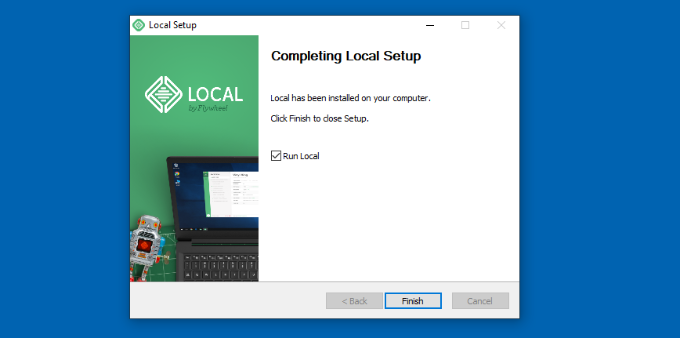
O software será iniciado em seu dispositivo Windows.
A próxima etapa é adicionar um novo site local. Para fazer isso, basta clicar no botão de adição “+” na parte inferior.
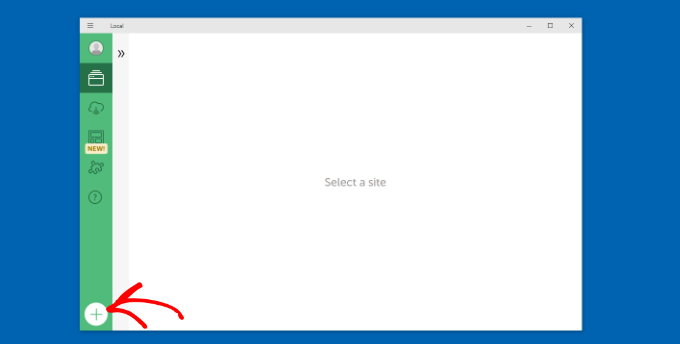
Depois disso, você pode criar um site no software Local.
Selecione a opção “Criar um novo site” e clique no botão “Continuar”. Também há opções para criar o site a partir de um projeto ou de um arquivo de site existente, mas vamos escolher a primeira opção para fins de demonstração.

Em seguida, você pode inserir um nome para seu site local, como “My WordPress Website”.
Há também opções avançadas em que você pode inserir o domínio do site local e o caminho do site local. Por padrão, o domínio usará o título do seu site, mas separado por traços.
Quando terminar, basta clicar no botão “Continue” (Continuar).

Depois disso, você precisará escolher um ambiente para seu site local.
Você pode usar o ambiente “Preferred”, no qual o software selecionará automaticamente a versão do PHP, o servidor da Web e a versão do MySQL. Por outro lado, você também pode selecionar “Custom” (Personalizado) e inserir os detalhes do ambiente.
O Local WP oferece as versões mais recentes do PHP. Quanto ao servidor da Web, você pode escolher entre Nginx ou Apache. Você também pode escolher entre MySQL ou MariaDB para os bancos de dados.
Observe que algumas versões de PHP, servidor da Web e banco de dados exigem o download de algumas dependências para que funcionem corretamente.
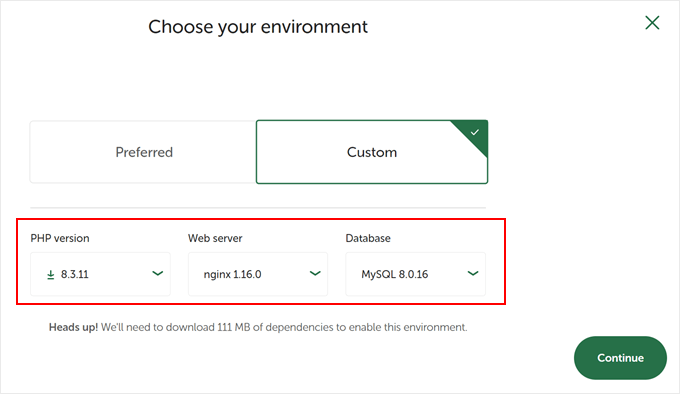
Em seguida, você pode inserir um nome de usuário e uma senha do WordPress para o seu site local. Além disso, há também uma opção para escolher um endereço de e-mail do WordPress no qual você receberá todas as notificações por e-mail.
Além disso, há uma opção avançada em que o software perguntará se você tem uma rede WordPress multisite. Caso contrário, basta clicar em “Não”.
Depois de inserir esses detalhes, basta clicar no botão “Add Site”.
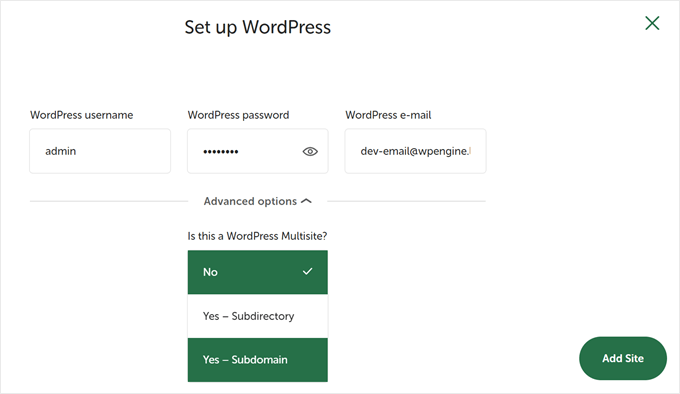
O software agora instalará o WordPress e configurará seu site.
Para iniciar o site local, clique no botão “Start site” (Iniciar site) no canto superior direito.
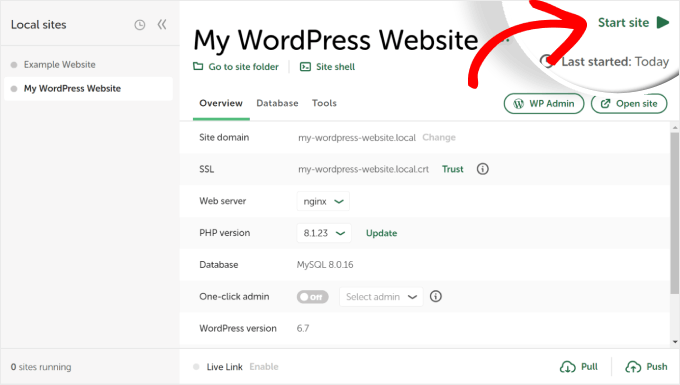
Em seguida, clique no botão “WP Admin” e você verá a página de login do administrador do WordPress.
Basta digitar o nome de usuário e a senha que você digitou anteriormente ao configurar o site local e, em seguida, clicar no botão “Log In”.

Agora você pode editar o site local em seu computador Windows.
Quando terminar, não se esqueça de interromper o site do software Local WP clicando no botão “Stop site”.
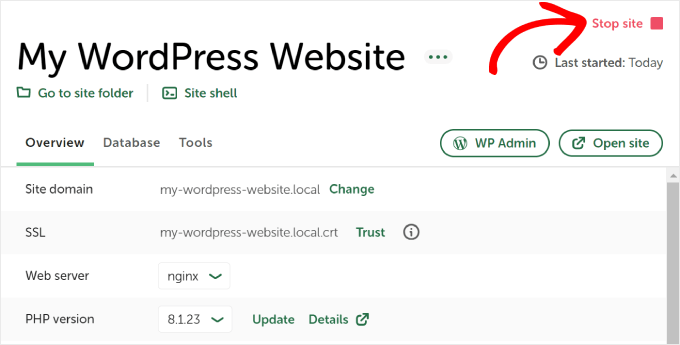
Dica profissional: se quiser ignorar o processo de login, você pode ativar um login de administrador com um clique no Local WP.
Para fazer isso, basta voltar ao painel do Local WP e alternar o botão “One-click admin” até que ele diga “On”. Em seguida, no menu suspenso, selecione o usuário administrador que pode usar esse recurso de login com um clique.

Alternativa: Use o WordPress Playground para testar temas, plug-ins e muito mais
O WordPress Playground é uma ferramenta inovadora que permite fazer experiências com o WordPress diretamente no navegador da Web. É uma caixa de areia virtual onde você pode experimentar novos temas, plug-ins e recursos do WordPress sem afetar nenhum site real.
O WordPress Playground é diferente de um ambiente local do WordPress em vários aspectos importantes.
Primeiro, ele não requer instalação em seu computador e é redefinido após cada uso, ao contrário das configurações locais permanentes. Você pode acessá-lo de qualquer dispositivo com um navegador, enquanto as instalações locais estão vinculadas a um computador.
Embora o WordPress Playground seja ideal para testes rápidos e aprendizado, um ambiente local do WordPress em seu computador Windows oferece mais flexibilidade para projetos de desenvolvimento de longo prazo.
Para obter um passo a passo detalhado, consulte nosso guia sobre como usar o WordPress Playground em seu navegador.
Instalei o WordPress em meu computador Windows, e agora?
Agora que você tem o WordPress em seu computador, aqui estão algumas coisas que você pode fazer:
- Aprenda dicas e truques básicos do WordPress para usar melhor seu site.
- Experimente diferentes temas do WordPress para ver como seu site pode ficar.
- Instale e teste os plug-ins obrigatórios do WordPress para adicionar novos recursos ao seu site.
- Saiba como corrigir erros comuns do WordPress por conta própria.
- Experimente diferentes construtores de páginas do tipo arrastar e soltar para deixar seu site mais bonito.
- Saiba como redefinir a senha de administrador do WordPress no localhost para recuperar o acesso ao seu site.
- Configure fluxos de trabalho automatizados para facilitar o gerenciamento de seu site.
- Saiba mais sobre a segurança do WordPress para manter seu site protegido contra hackers.
- Mova seu site local do WordPress para um servidor ativo quando estiver pronto para compartilhá-lo com todos.
Esperamos que este artigo o tenha ajudado a aprender como instalar o WordPress localmente em um computador Windows. Talvez você também queira ver nosso artigo sobre como instalar o WordPress localmente em um computador Mac e nosso guia definitivo para criar um site de teste do WordPress.
Se você gostou deste artigo, inscreva-se em nosso canal do YouTube para receber tutoriais em vídeo sobre o WordPress. Você também pode nos encontrar no Twitter e no Facebook.





Bidyut Kumar Mondal
Thanks a lot for such a wonderful post.
Ali
Just to say Thank you very much.
sreenu
thank you…thank you soooooooooooo much ..
Nissim
Thank you so much. this was sterling
adriana
OMG i made it through. lol. thank you for your time writing this, it helped me through the panic stage lol
mahendra
Who help of peoples, They are God
Kenneth Ekeh
Help please! I have followed the article and installed wamp, created the wp database but culd not be able to run complete configuration of wp. Its telling me “can’t select database”. Try Again. Please help me to fix this. Thanks.
WPBeginner Support
During the installation when it asks for your database details, please make sure that you are entering the same name for the database which you used when creating database in phpmyadmin. For username, use root and leave password blank.
Admin
Tom
Upon opening mysql workbench, choose your connection, then write the code without quotes “create database nameofyourdatabase;” this will be the name of your database and what you will use in the wordpress setup when it asks for the name of your 1)database(use nameofyourdatabase) 2)username 3)password 4)database host(im using “localhost”)
Hope this helps.
Tammi L. Coles
Just a quick note of thanks for this very simple-to-follow tutorial. It worked like a charm (including the Apache rewrite for permalinks follow-up).
ogunmakinwa dayohanks.
Your tutorials as been good for me so far, but please which stable wordpress can i download? can i download the latest version? i am just thinking that some plugins might not be available for the latest version.. so for now which version do you recommend for me? thanks
WPBeginner Support
We always recommend using the latest stable version of WordPress.
Admin
Mohamed Ishag
Hi there,
Would you please answer the question posted on 12/11/13 I still need help
as I am unable to run the WAMP Server on Windos 8. Please read question posted on 12/11/13.
Thank you in advance.
Regards,
Mohamed
Orestes
I was able to install WP, but I’d like to know how to manage different web logs within my local server. Thank you for the instructions and tutorials here.
WPBeginner Support
you can install different weblogs (blogs or websites) on the same server by installing wordpress in different sub-directories inside your
/wamp/wwwfolder. For example:C:\wamp\www\site-1 will open in http://localhost/site-1
C:\wamp\www\site-2 will open in http://localhost/site-2
Admin
GinoDC
After entering details for Site Title, Username, Password and Email I press Install WordPress and my computer hangs. Please help.
WPBeginner Support
This could happen for a number of reasons. Try to uninstall wampserver and then download and reinstall again. If the problem presists, then you can try XAMPP.
Admin
Mohamed Ishag
Hello,
I have installed WAMP on Windows 8 but I am having a problem creating a data base due to the following error (You don’t have permission to access /phpmyadmin/ on this server). I have edited the htpd.conf file as follows
Open file httpd.conf through wamp tray icon
Find:
# onlineoffline tag – don’t remove
Order Deny,Allow
Deny from all
Allow from 127.0.0.1
Change to:
# onlineoffline tag – don’t remove
Order Deny,Allow
Allow from all
Then saved but still get the same error, why!? Norton 360 is installed on the PC
and no other conflicting apps. I need some help to fix this issue. Any ideas? Thank you in advance.
Best Regards,
Mohamed
Mohamed Ishag
Dear Syed and the team,
Thank you very much for this site. I am new to WordPress and found your tutorials and explanation very good and straight forward. I feel that you are a busy man but still have time to dedicate this site to new WP beginners. God bless your parents.
Salam,
Mohamed
adam
Hello,
I have installed everything and am finally at my wordpress dashboard on my localhost machine. everytime i click on visit my site to view what I have changed the page simple directs to the WAMP server configuration screen that shows apache version, php version, loaded extensions, etc… It seems that something simple needs to be changed but I dont know…Can anyone please help? Thanks in advance…
WPBeginner Support
You have probably installed WordPress in www directory. You need to install it in a subdirectory like www/testsite1/
Admin
Nuno
Hey i have the same problem, so if i just copy all the files to a subdirectory it will work or do i have to reinstall it all over? Thanks.
Matthew
Thank you, than you, thank you. I am a technophobe and your clear instructions helped me all the way.
Arthur
Hi,
After installing WAMP in accordance with your instructions, I could not open phpmyadmin; explorer kept waiting for localhost. I’m not a pc techie so I desperately need instructions how to proceed furter in the same easy way as your manual above. I have a 64 bit W7 machine, and installed the 64 bit version of WAMP first, but since that did not work as described , I installed the 32 bit, but with the same result. Thanks for your help in advance ! (No Skype, port 80 OK, as far as I can see)
WPBeginner Support
Try restarting all services make sure that WAMPServer icon is green also make sure that Skype is not running in the background. Also look at this support thread for more possible solutions.
Admin
Arthur
Thanks a lot: I followed your recommended thread and I removed a double line in the Host file (‘127.0.0.1 Localhost’) that seemed too much and now I can get to a log-in page of phpMyAdmin, which is great, but I have not yet even entered an ID and password during initial installation of WAMP. Did I miss something ?
Thanks for your patience again…
WPBeginner Support
To log in to phpMyAdmin, enter username root and leave password blank.
Trudy Ritsema
Can I run more than 1 test site on WAMP? and any ideas of how I would go about this please?
I already I have localhost site running – and I don’t want to get rid of that yet as I am still developing it…
Thanks in advance.
WPBeginner Support
in your www directory create new directories for each website. That way you can run multiple sites on localhost.
Admin
viki
i can’t create new database, bcause it is showing ” * No Privileges” in red colour letters. please help me
WPBeginner Support
you are probably entering wrong credentials to connect to your mysql database.
Admin
nick mav
you should login using the following credentials:
username: root
password: [empty] –> that is, no password
Shawn Morrissey
Thanks Nick,
I had the same issue and couldn’t find this out anywhere I had looked previously…
SanketP
Hi. I am a new-bee to this world of eb designing. Wanted Joomla but that didnot go thru too well. WP instal was as good for me. Thank you. XOXOXO.
Everett
Hello. I want to be able to develop my wordpress site locally and not have to be connected to the web when I make changes and do save or update inside wordpress. Before I go through all the installation of WAMP and WP locally, can anyone tell me if I will have to have internet access to make updates to a wordpress running locally in WAMP? Sure I realize if I wanted a new Theme or Plugin, I would have to be online, but if I am just making adjustments to text and adding pictures that are already on my laptop, etc. will I have to have internet access to do so? I ask because I do a lot of travel where I am on an airplane and could be working on a new version of a website if I don’t have to be online. Also, I can’t afford a wireless account for my laptop, so I only have internet when I am at home with my own wifi or when I am somewhere that has a free wifi. Thanks.
WPBeginner Support
no you do not need an internet connection to work locally on your website.
Admin
Ian
I followed the instructions to the letter, installed WAMP and the required SP1 Visual C++ on a brand new laptop running Windows 8 64bit. The installation refuses to launch, brings up a screen asking if I’m sure I want to let this programme make changes to the computer, then does nothing when ‘Yes’ is clicked. What is going wrong?
WPBeginner Support
Does the wampserver icon appear in your windows taskbar? If it does, then you need to click it and launch wampserver.
Admin
Brynn
Please help. I installed WAMP but when I went to open phphMyAdmin, nothing happens. I tried uninstalling and reinstalling, but still getting the same problem. I’m not even getting any sort of popup block notification in my browser. Just nothing.
I wonder if this might have something to do with the WARNING window that popped up on the WAMP website before I downloaded it… It said something in French, and then something about needing to install C++ which I know nothing about, and which was not mentioned in this tutorial.
Do I need to install C++ and if so, do I need to learn how to use the programming language before I can finish this tutorial on installing WordPress? I am a designer, not a programmer, so I hope to god I don’t need to stop everything and go learn C++ before I can do a simple WordPress install.
WPBeginner Support
Brynn you can always check whether or not Microsoft Visual C++ is installed on your computer from Control Panel -> Programs and Features. Do you see wampserver page when you visit http://localhost? If you do, then you have already successfully installed WAMP.
John Victor
Can I hug you now or later?
Anudeep
Awesome tutorial
guru
I install wordpress to my localhost. But i dont know to use it to develop a site. I’m new to wordpress. Please anyone help me.
WPBeginner Support
Take a look at our beginner’s guide section. For theme development you may want to take a look at our WordPress theme cheat sheet for beginners.
Admin
Scott Cho
Got WAMP installed, but when I try to create a new databse by clicking on the phpMyAdmin button in WAMP the chrome browser window that opens up says:
Forbidden
You don’t have permission to access /phpmyadmin/ on this server.
Can anyone point me in the right direction as to what this is and how to fix it? I don’t know if this makes a difference but I have it installed on my secondary hard drive, not my C drive (the c drive just has my operating system).
Asad Riaz
Here is how you edit the htpd.conf file
Open file httpd.conf through wamp tray icon
Find:
# onlineoffline tag – don’t remove
Order Deny,Allow
Deny from all
Allow from 127.0.0.1
Change to:
# onlineoffline tag – don’t remove
Order Deny,Allow
Allow from all
Plus resolution to some other conflicts
Make sure no other program conflict wamp such as Xampp, phpEasy, IIS, Skype, Zonealarm, firewall/antivirus, NOD32, Eset, any web and/or Remote Desktop related program, such as Teamviewer …
IIS and Apache/Wamp are both web server and might conflict in some way, so you have to disable IIS in order for Wamp to work
Disable IIS in Vista/W7:
Control Panel, Uninstall Programs, Turn Widows Features On or Off, uncheck Internet Information Services
Disable IIS in XP:
Control Panel, Add/Remove Programs, Add/Remove Windows Components, uncheck Internet Information Services (IIS)
Restart computer, then restart Wamp
Also, in folder C:\WINDOWS\System32\drivers\etc, open file hosts and delete anything in this file and have only this line below and nothing else
127.0.0.1 localhost
If using Skype, go to Tools->Options->Advanced->Connection and uncheck the box “Use 80 and 443 as alternatives for incoming connections”. Restart Skype after WAMP. Now you will be able to use both programs at the same time w/o problems.
I hope it helps, found it on net
Asad Riaz
Howdy,
Well i have managed to install it using the article. Some info was missing in this article like
1. Once you click on phpMyAdmin, it asks for login details, so here they are:
username: root
pass: (leave it blank)
2. WAMP sometimes gets offline and it wont open the phpMyAdmin page, so you guys need to edit the htpd.conf file in C:wamp/bin/apache4.2/conf/htpd
Lets see now how much it helps me.
I m here for all the support that i can extend.
Thanks to the author of this page.
Cesar M.
thanks for the user info I was getting crazy, but I finally got in to phpmyadmin
Colin Teasdale
Hiya,
Problem solved – I had needed to install the Visual C# redistributable, and did that after installing Winamp. Uninstalled Winamp, rebooted and then re-installed – everything fine. That’ll be user error then ! ! !
Colin T.
Scott Cho
I’m getting the same error you just described below, where is this redistributable you speak of?
Colin Teasdale
Hi guys,
I’ve just downloaded and installed WAMP and have got to the “set up a database” stage. When I select ‘phpMyAdmin’ I get a ‘Firefox Problem Loading Page’ page with “Unable to connect – Firefox can’t establish a connection to the server at localhost”.
I’ve tried the fix suggested by Imran on June 17th, but this doesn’t seem to have fixed resolved the problem.
Any thoughts on how I fix this, please??
Peter
Hi Editorial Staff,
Do you have a tutorial that is the reverse process also using WAMP? I have a functioning website that I would like to duplicate on my home computer for experimenting and learning css, and php programming without risking my functional website.
Thanks.
EL
That is exactly what I need!
Denzil
Hi, a very useful article, thanks. Is it easy to migrate a test WP site on WAMP to a hosted site elsewhere? Do you have a tutorial article to help?
Thanks
Editorial Staff
Yes, it is fairly easy to do that. Tutorial will be coming tomorrow
Admin
Denzil
Great! How timely! Thanks guys, looking forward to it.
Kate BP
Absolutely cracking article – really helpful, thanks so much!
akash
After clicking on phpmyadmin,,,,,,,
i am getting redirected to directly php my admin webpage and not the database entry option which is shown above.
thereafter the details are not matching afterwards in database,username and password.please give me its solution as soon as psbl.
Amitoj Gautam
User Name: Root
Password: None (Leave this space empty)
Click on the Go button. You will be directed to the page you are looking for.
Dana
Hi! Once I’ve created a site on my WAMP server, could I then transfer it to an existing domain name? I’m trying to create a new site without shutting down the old one. Once the new one is finished, I would want to replace the old one, but use the same domain name. Thank you!
Editorial Staff
Yes you can do that. We have updated the article to add a link to the tutorial.
Admin
vahid
Thank you so much
chris martin
Hi, I am having trouble with links not working. Could you help me or give me some direction on how to fix that? On my site “chrisjamesmedia.com” click menu, then “blog” and i get “not found”. This also happens with links as well.
Also, do you have a tutorial on how to host multiple domains from this as well, or point me in the right direction.? I have looked up several things about virtual domain, localhost, and everytime I find something they want me to edit httpd conf, but what they have doesnt match mine.
Thank you so much!!!!
Tamsin
Hi,
Great article, very clearly explained.
Would you be able to tell me the best way to add a second WordPress site to Wamp? I have read a lot of conflicting information and would rather not make a massive mess of things!
Editorial Staff
Create a new folder inside your www folder, then repeat this process.
Admin
Tom Smith
Hi,
Thank you for providing this excellent tutorial! It’s going to be great to get use to using WP onn my PC before I install it on my host server and create my website.
I followed your instructions and installed WAMP and then WordPress and got all the screens you showed here… and with the tweaking you suggested, I was finally able to open WP – saw the Dashboard, etc. Then I closed it.
But now I can’t seem to open WP. I open WAMP and click on Localhost – and it just sits “waiting for response from localhost” – does not open anything. I’ve tried http://localhost/my database name – it will not open – I get “HTTP 500 Internal Server Error”. Just in case, I also followed your instructions on SKYPE and unchecked that Port 80 box.
What am I missing?
Editorial Staff
Did you shut down your computer? You have to launch WAMP Server every time you restart your computer.
Admin
Imran
When i try to Setting Up a Database for WordPress, it was saying like this : Forbidden
You don’t have permission to access /phpmyadmin/ on this server. what is the reason ? can you please guide me. thank you in advance….
Editorial Staff
That’s weird. Since you are the admin of your Wamp install, then you shouldn’t get this error.
Admin
Imran
Finally i got the solution…
I think it will be useful for others.
for phpmyadmin
Goto c : wamp/alias/phpmyadmin.conf file, open with notepad.
find
Options Indexes FollowSymLinks MultiViews
AllowOverride all
Order Deny,Allow
Deny from all
Allow from 127.0.0.1
replace with
Options Indexes FollowSymLinks MultiViews
AllowOverride all
Order Deny,Allow
Allow from all
thats it…
Imran
Thank you very much EDITORIAL STAFF, this is a nice post and very usefull.
Melanie
I had this same problem with the phpmyadmin and I found and made the changes cited here to the alias file, then restarted WAMP and I was able to create my database. However, now I’m getting the same Forbidden message when I try to install WordPress on my localhost, exact text below:
Forbidden
You don’t have permission to access / on this server.
I can get to the WP install screen from 127.0.0.1, but not localhost. I’m running Windows 8. Any ideas on how to get this to install? Thanks in advance for any help you might be able to give me.
Akshay
Hi.
I wanted to use this method to test out plugins before installing then on my live site. So in your tutorial, instead of copying in clean WordPress files, I copied in a full backup of my site made using BackupBuddy.
However from this point on I’m not sure what to modify in order for my site to function correctly offline. I edited my wp-config file to the new database details, and imported my database from my online phpmyadmin to the WAMP one. However it seems like there’s something I’m missing, as when I try to access localhost/site/wp-admin I am redirected to my online login page.
Do you have any suggestions?
Thanks very much for your help.
Akshay
Brandi
I’m in the same boat – did you ever find a solutions?
Christophe R.
Another (lazy) point for XAMPP : I know there are some differences in the config files, but I use both linux (at home) and Windows (Seven and 8) at work, so I appreciate having the same interface for I only have to learn once.
Andre
Great article and easy instructions for those who want to venture into WAMPP….however, for myself, I still prefer XAMPP and do run it on it’s own on a second drive without the installable version. Updating is a breeze, although I rarely need to.
I’ve used XAMPP for many years now for both WordPress and Joomla theme development, as well for a testing server. Never had issues and I do find it quite easy to use. I used to use the full version but I found that the Lite version works extremely well.
I noticed someone said AMPPS, but I’ve never tried that…perhaps in my spare time I will try it out.
Nicholas
Its click and install that’s how easy it is and just open to localhost/ampps i use it for all my scripts that this includes as downloads and install on the service. no worries on xamp and wamp that i found to limited in some ways.
Adrian
Thanks alot it was really helpful
Thomas
Hi everyone,
I’m a very beginner with WordPress and I have created a site with it and WAMP on my computer.
Now I want to put it online, but I don’t know how to do it.
Where does a tutorial exist for that?
The thing is that I want to replace the current site, which is hosted somewhere else, and so keeping the domain name.
Does anyone know where I can find this kind of information?
Thanks a lot!
Nicholas
WAMP in the older days was great! Now there is a far more better and less embarrassing way when it comes to configuring things with WAMP. WAMP is in the past and gone for me. I use AMPPS far more better no configurations, just install and a few dips of changes in the options section that’s it. Open your browser go to your localhost and install any cms or other scripting lang within your browser using ampps. You’ll be amazed! No more downloading then extracting in www folder and then reconfiguring. WordPress is just a click and install on ampps. No hassle! Shouldn’t you guys write something about AMPPS? This is a lot more better than WAMP! WAMP lags a lot of things like cgi and stuff those are extras, but on ampps everything is included. Ever since ampps I never looked back to wamp! Sorry!
Editorial Staff
Have been using WAMP for so long that didn’t even bother with another option. AMPPS sure looks good. Good to see that it is made by the folks from Softaculous. Will have to give it a try.
Thanks for the suggestion Nicholas.
Admin
Zimbrul
Why do you say you prefer WAMP over XAMPP?
Alexander Gounder
WAMP is much simpler and easier to use compared to XAMPP.
Editorial Staff
Would second that. WAMP is easier to use. Several years ago when we used XAMPP the upgrade process was complicated and it was buggy. We switched over to WAMP and it was awesome.
Admin
Parth S.
Hi, Thank you very much for this. It’s very informative and easy to follow. However I’d suggest you mention the skype thing a lil early around the localhost point, because, there ppl start to worry when they see a blank screen with skype on in their PC.
Great post though. Keep it up.
Mladen
Just to mention, that Team Viewer also causes problems with WAMP.
Christophe R.
I actually do prefer XAMPP and DTX-Control for I can overcome security policy : Installation without administration rights (zip file pour the web server) and full access to blocked ports (80, 443, 3306).